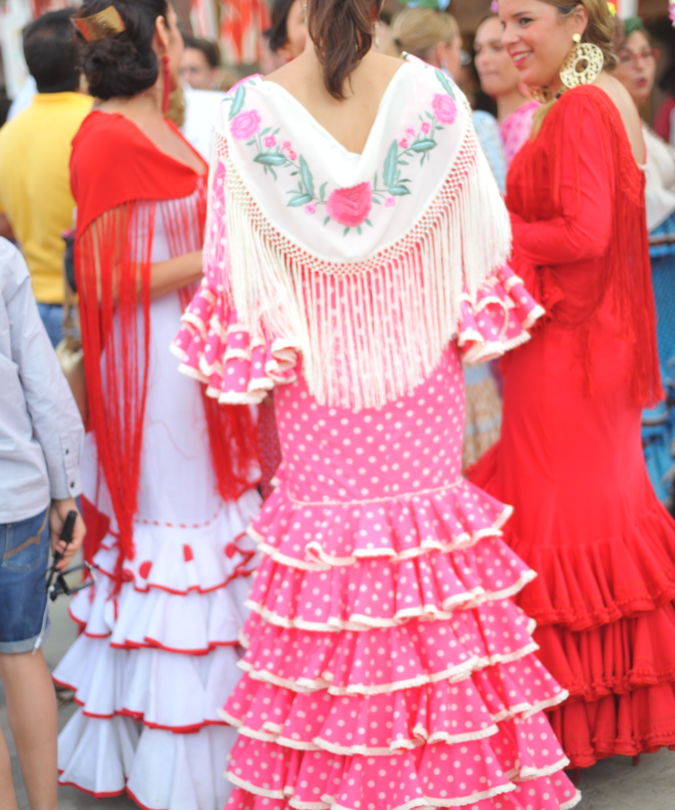‘On this day…’ A photo floats to the surface of my phone, tantalising, torturing. The sky shades from azure to powder blue; two young women in sun-yellow matador jackets and wide-brimmed hats stand either side of an ice bucket full of small bottles of Solear sherry.
It is April 2018, and we are afloat on the canal adjoining Seville’s Guadalquivir river during Feria, the week-long bacchanal that celebrates the end of Lent, the imminence of summer and really, just the joy of celebrating. Black carriages with golden wheels push between townsfolk in fantastic flamenco outfits – frills unfurling from wrist and ankle, flowers atop upswept hair, even children in bright, traditional dresses with little shawls strung across their shoulder blades. We are the guests of Barbadillo, which makes Solear, and as we dance into the night, pale, mouth-watering Manzanilla seems to flow more copiously than the river.


Manzanillas are dry sherries from Sanlúcar de Barrameda, the town at the mouth of the Guadalquivir that is one point of the Sherry Triangle (along with Jerez and El Puerto de Santa María). In the old warehouses (or, to give them their more romantic Spanish name, bodegas), salt-laden Atlantic air seems to insinuate itself into the stacked barrels, so that Manzanillas tend to have a lick of iodine, an almost imperceptible brininess, that the equally dry Finos, mostly from Jerez farther inland, do not.
Those barrels form a solera, whereby the new sherry is poured in at the top as the aged liquid is extracted from the bottom, the years mingling gently as they descend, progressively, towards the bottle. I love this system, so reminiscent of humanity: who am I, after all, but the current expression of a blend of others passed down through living vessels, enriched by each addition from one century to the next?

The English passion for sherry goes back at least to the 16th century, and Sir Francis Drake’s theft – sorry, appropriation – of a vast quantity of sherry while setting fire to the Spanish fleet in 1587. But, as Julian Jeffs points out in his book Sherry, there had been fortified Spanish wine in England at least 200 years before that: Chaucer warned readers of The Pardoner’s Tale to stay away from the white wine of Lepe, ‘of which there ryseth such fumositee, That when a man hath drunken draughtes three, And weneth that he be at home in Chepe, He is in Spain, right at the town of Lepe’ – which is just along the coast from Sanlúcar.
The Pardoner’s warnings notwithstanding, the idea of three ‘fumositous’ swigs landing me instantly in Andalusia is alluring. I have derived comfort from dry sherry since my teens: it was my father’s favourite aperitif, with peanuts or a hunk of bread topped with salty fish, and his preference has trickled down. These Finos and Manzanillas age under flor, the naturally occurring yeast that imparts freshness, nuttiness and appetising acidity, and while they’re all made from the Palomino grape, they range in flavour from Solear’s buoyant quaffability to the almost chewy, biscuity depth of Gonzalez Byass’s Una Palma. They offer a sense of possibility – this is, after all, an aperitif – as well as those alluring fumes (the wines are fortified to around 15%). They are both strange and entirely familiar… yet in France, where I spend much of my time, they are impossible to find.
Why, I ask the French-born but UK-resident Anne Burchett, a wine marketing specialist and author of the novel Tasting Notes. “Sherry tastes very odd to a French palate,” she points out. Given that many of the English still think the sweet cream sherries are the only kind, that can’t be it though. There is also, she acknowledges, a bit of French snobbery at play – “In my day, you went to Spain to buy cheap cigarettes and maybe cheap spirits, but wine? Non.” Then there is the habit of staying local for your apéro, be it pastis or Lillet or Pineau des Charentes (to which I, in turn, say an equally vehement non).


So, no sherry until my return to England, which deprives me of two countries at once. Citrusy La Guita Manzanilla evokes the perfumed orange trees of Seville; the Antique Fino of Fernando de Castilla, which has the smoky self-importance of a card-players’ cavern, brings wistful memories of a terrific dinner in Jerez. But inhaling the Finos that Sánchez Romate makes for The Wine Society transports me somewhere else: to a kitchen in south London where my long-dead father stands with his pre-prandial glass. This alien scent is also, for me, the smell of a home that has vanished as irretrievably as Chaucer’s Cheapside.
There is another river that runs through the Sherry Triangle, pouring into the sea at El Puerto de Santa Maria, south of Sanlúcar. In Arabic, Guadalete means “river of forgetfulness”, and I love the idea of my memories floating along the Guadalquivir with forgetfulness just below, and all the sherry bodegas between, keeping the two in dialogue. Feria, of course, is cancelled this year. But one day we will dance again, and share seaside plates of the giant Sanlúcar prawns called langostinos as the sherry glasses empty and refill with the sweet inevitability of the tides beyond. Memory comforts us for our losses… but so much in life is cyclical, and, as I keep telling myself, much that we remember will return.







